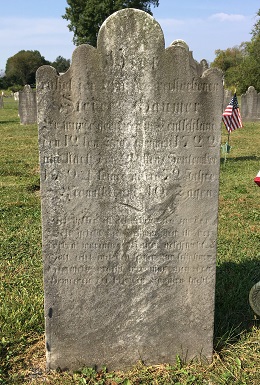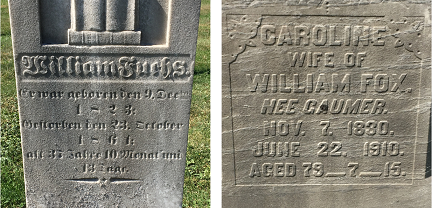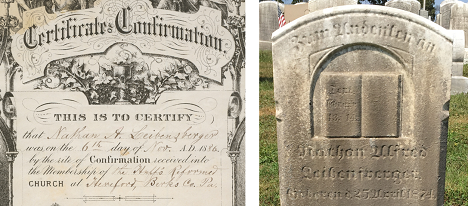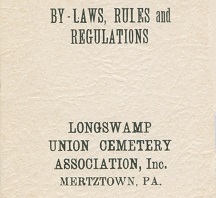
This blog actually has nothing to do with marine biology, except in the inspiration.
Rather, it’s about a September 2019 genealogy research trip I made to Longswamp Township and other communities in the Reading-to-Allentown corridor of Pennsylvania. My objective was to find and photograph grave markers of early generations of our Pennsylvania German cousins of the Gaumer surname, who did not migrate westward, especially those in the old German gothic script. I also wanted to document the extent to which generations of cousins continued to use the German language over many decades.
With stops at 10 cemetery sites, I came home from the weekend with digital, high resolution photographs of more than 280 grave markers and the church buildings, some ancient, where the burying grounds are located. These graves represent 21 different branches of offspring of Maria Elizabeth Meinert and her husband, Revolutionary War veteran Johan Dietrich “Dieter” Gaumer, of near Alburtis, Lehigh County, primarily their children Johann “Heinrich” and Anna Margaretha (Meitzler) Gaumer and Heinrich “Henry” and Maria Gertrude (Gaumer) Meitzler.
It took several weeks to process and name all of the digital image files; color-correct, crop, resize and add each to its respective biography on the Minerd.com website; and then sort and place all of them into permanent digital folders for easy access in the future.

The trip was inspired by John Steinbeck’s non-fiction book, The Log from the Sea of Cortez, which I first read in 1991 and have consumed several more times since then. It’s a recap of a trawler boat trip which he and marine biologist Ed Ricketts made in 1940, on the eve of World War II, down the California and Mexico coastline and then up into the Mexican Gulf of California. Their goal was to make frequent stops and go ashore to explore the vast diversity of rich marine life – sea cucumbers, starfish, mollusks – found teeming in the coastal tide pools, rocks and sand. They took specimens and recorded color, size and shape characteristics and noted their geographic distribution as compared with other parts of the region.
The offbeat, often-philosophical book reinforced to me that, if I were to truly shoot the moon and learn about the totality of our Meinert/Minerd family within Americana, I’d need to regularly travel and find and excavate the paper trail of the nooks and crannies where they lived their lives – their “tide pools.” Since then, often in company with cousin-researcher Eugene Podraza, I’ve made annual summertime treks to Ohio, West Virginia, Indiana, Illinois, Missouri and Kansas, as well as to the National Archives in Washington, DC.
And over the past few years, I’ve immersed myself more deeply into early cousins’ Pennsylvania-German lifestyles and customs, even reading further back about Martin Luther, Goethe and the Thirty Years War to try to figure out what our forefathers brought with them from the old country. From their life stories, we can learn the German folkways of our cousins which were otherwise lost over time.
Here’s one of my favorite excerpts from Steinbeck’s book:
A number of times we were asked, Why do you do this thing, this picking up and pickling of little animals? To our own people we could have said any one of a number of meaningless things, which by sanction have been accepted as meaningful. We could have said, ‘We wish to fill in certain gaps in the knowledge of the Gulf fauna.’… The lies we tell about our duty and our purposes, the meaningless words of science and philosophy, are walls that topple before a bewildered little ‘why.’ … [W]e did these things because it was pleasant to do them.
10 Findings from the Longswamp ‘Tide Pools:’
1. The Pennsylvania German language can be viewed in three perspectives, as spoken, written and read. The grave markers certainly reflect the latter two as inscribed on stones throughout the 1700s, 1800s and even into the 1900s. Surprisingly, in researching the lives of these families, it’s clear that the spoken version remained in the common speech well into the 20th century. I’ve found one story in 1914 where four-year-old cousin Herbert Acker, who accidentally wandered onto trolley tracks 60 feet above ground in Allentown, was warned by a panicked vehicle operator in both English and German to “stand still” so he would not fall.

2. The German language had looooong staying power. It was humbling to stand at the grave of Elizabeth Meinert’s husband, Revolutionary War veteran Johannes “Dietrich” Gaumer (1722-1794), in Zions Lehigh Evangelical Lutheran Church Cemetery in Alburtis, Lehigh County. At least five generations of their descendants, over the span of some 200 years in Pennsylvania, used German as their primary tongue. In his day, Benjamin Franklin was so afraid of the strength of German culture that he wrote the following:
Why should the Palatine boors be suffered to swarm into our settlements and, by herding together, establish their language and manners to the exclusion of ours? Why should Pennsylvania, founded by the English, become a colony of aliens, who will shortly be so numerous as to Germanize us, instead of our Anglifying them?”
The Gaumers’ great-great grandson Henry S. Miller (1872-1949), of the Heimbach branch, was a talented stone cutter who inscribed hundreds of grave markers over the years in the Allentown area. Reported the Allentown Morning Call dryly in 1945, after Nazi Germany’s defeat in World War II, “Mr. Miller specializes in raised lettering. In former years he also worked much on German script for monuments. He did the last one five years ago. There is no longer a demand for it.”

3. These families held strong Christian beliefs. Across the top of many of the markers is carved the phrase “Zum Undenten An,” which in English roughly means “For the moment” … here lies the body of, which reflects their belief in the Christian Resurrection of the dead. At the base of many of the markers also is inscribed a brief Bible reference. One example is the grave of Leah Lovina (Conrad) Wetzel — of the family of Johan “George Wetzel — in Longswamp Cemetery, Berks County. The text reads “Psalm 73:23, 24, 25.” One has to actually look up the passage. The King James Version reads: “Nevertheless I am continually with thee: thou hast holden me by my right hand. Thou shalt guide me with thy counsel, and afterward receive me to glory. Whom have I in heaven but thee? and there is none upon earth that I desire beside thee.”

4. Cousins of the 1800s and early 1900s were fluent in both German and English. As they evolved to English over time, names and spellings changed, potentially creating confusion for future generations and genealogy researchers like me. One example was the couple William and Caroline (Gaumer) Fuchs. William and two of their daughters became deathly ill in 1861. On Oct. 23, he succumbed at the age of 37, and the daughters followed him to the grave shortly after. All three were buried in Huff’s Union Church Cemetery, Berks County, with their grave markers inscribed in the old German script, their surnames written as “Fuchs.” Caroline outlived her husband and daughters by nearly a half-century. In June 1910, she died at the age of 79 after a stroke. Her name as inscribed on the grave marker was spelled the English way, “Fox,” on a stone located many rows away from his.

The pattern of language evolution was uneven. An example was the story of Nathan Alfred Leibensperger, of the family of Sarah “Sally” (Wetzel) Heimbach. At the age of 12, in 1886, he was confirmed in the family house of worship, Huff’s Reformed Church. In joining the congregation, as had his brothers David and William Henry in previous years, he received a confirmation schein (certificate), signed by the church pastor, Rev. Eli Keller. Unlike his brothers’ German certificates, his was printed entirely in English. But sadly, when he died in 1891 at the age of 16, his grave marker was inscribed in German.

5. Pennsylvania Germans placed an importance on maiden names. Many of the married women’s grave markers included such a reference. One example is the aforementioned “Sarah Heimbach, geborn Wetzel” found in the Huff’s Church Cemetery. It translates to “Sarah Heimbach, born Wetzel.” This practice continued even after stones began to be cut in English.

6. Pennsylvania Germans’ churches evolved beyond the traditional Lutheran, reflecting some of the cultural tensions of the time in the struggle over losing their identity. Certain Lutheran factions wanted their worship services to be in English rather than German and to do away with outdated practices. Some splintered off and formed their own Reformed church congregations but, alas, could not always afford their own buildings. Thus the two would share facilities and burying grounds even with different governing bodies and pastors.

Over time, these became known as “Union” churches and, at some point, some of the Reformed congregations merged with the Church of Christ. This led to all sorts of confusion over governance issues. One example is the case of cousin Victor Franklin Fegely (1876-1941), of the family of Jesse Fegley. Circa 1923, Victor served as secretary of the joint congregations of the Longswamp Church. He also helped to formally incorporate a Union Cemetery Board, and was named in the association’s By-Laws, Rules and Regulations booklet.
7. While some of Elizabeth Meinert Gaumer’s children migrated into Ohio, many more chose to stay in Berks and Lehigh Counties. After the span of a dozen generations, their offspring are still there. In the hundreds. In the thousands. Or more, all living in the region today.

8. Despite the image of Germans as iron-willed and stoic, they were filled with emotion, especially in grief. One of the more poignant examples is shown by the grave marker for William “Henry” Leibensperger, of the Heimbach branch, who died at the age of 24 in 1885. The funeral text was based on Psalms 102: 24-25, a reference inscribed on the face of his marker. When looked up, the verse reads (King James Version): I said, O my God, take me not away in the midst of my days: thy years are throughout all generations. Of old hast thou laid the foundation of the earth: and the heavens are the work of thy hands.

9. Pennsylvania German cousins, like their counterparts from other cultures, suffered from anxiety, heartache and mental illnesses which seem familiar today. It was heartbreaking to research the story of Mertztown residents Hiram R. and Katie (Miller) Fegely of the Heinrich “Henry Harrison” Fegely branch after photographing their and their family’s grave markers. Sadly, infant son Henry died in 1894 and one-month-old son James in 1907. After Katie at age 33 began to show symptoms of mental/emotional depression, she was admitted to the Pennsylvania State Lunatic Hospital in Harrisburg, diagnosed with “Melancholia recurrent exhaustion” and spent the final nine months of her life in the institution. She succumbed to her illness on Oct. 6, 1908. Hiram lived for another 19 years. On Christmas Day 1927, he used a razor to slice the common femoral artery on his left thigh, about six inches above the knee, and proceeded to bleed to death. Their markers, in English, are in the St. Pauls Union Church Cemetery in Mertztown.
10. The speed and technology of collecting have changed vastly since Steinbeck’s time. My trip depended heavily on my smartphone. On Steinbeck’s voyage, photography was an afterthought, and their attempted images and especially films were unusable. Maps were based on data which were years old. The camera on my phone was essential for instantaneous confirmation that my pictures were sharp and well-composed. When I could not find graves that I knew should be in a given cemetery, I was able to query Minerd.com and FindAGrave.com on my phone to confirm names, details, relationships and others’ research. The GPS feature on my phone also made it easy for me to easily navigate the country roads, twists and turns to arrive precisely at the desired location in the time GPS had estimated. This also allowed me to move quickly through the cemeteries in the shortest span of time possible, allowing me to complete the walking and photography in 10 burying grounds in about 24 hours (afternoon on Saturday and morning on Sunday).
Berks/Lehigh County Churchyards Visited the Weekend of Sept. 21-22, 2019:
Longswamp United Church of Christ, Clay Road, Mertztown
Christian Congregation Church, a.k.a. St. Pauls Union Church, Barclay/Chestnut Streets, Mertztown
Huff’s Union Church, Conrad Road, Alburtis
Zion Lehigh Evangelical Lutheran Church, Spring Creek Road, Alburtis
Greenwood Cemetery, West Chew Street, Allentown – drive through only
Union-West End Cemetery, North 10th Street, Allentown – drive-through
Zion’s Evangelical Lutheran Church, Kings Highway, Old Zionsville
Old Zionsville United Church of Christ, Fountain Road, Old Zionsville
Upper Milford Mennonite Church, Zionsville
Solomon’s United Church of Christ, South Church Street, Macungie
I like the quote by Benjamin Franklin, “Why should the Palatine boors be suffered to swarm into our settlements and, by herding together, establish their language and manners to the exclusion of ours? Why should Pennsylvania, founded by the English, become a colony of aliens, who will shortly be so numerous as to Germanize us, instead of our Anglifying them?” Now, the descendants of those reviled German immigrants say the same thing about other immigrant groups. The circle of life and all . . .
LikeLike